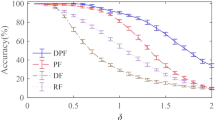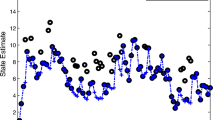Abstract
The performance of particle tracking velocimetry (PTV) is constrained by a practical issue, i.e., particle missing in a particle image frame. The randomly appeared loss-of-pair particles will bias the particle pairing relationship that is sought by particle matching algorithms. To handle this issue, this work proposes a general framework for the compensation of particle missing in PTV. Following our previous work (Nie in Exp Fluids 62(4): 68, 2021), we deal with the family of ant colony optimization (ACO) algorithms, which convert the task of particle matching to a global optimization problem for a particular objective function and seek a solution using ACO. To enable particle missing compensation, two core concepts are proposed. The first is to perform two symmetric ACOs from the forth and the back directions on a straddle-frame image pair, and then cross-validate the two sets of solutions to estimate the valid or problematic matching. The second is to make the action of the forth and the back ant colonies work in coordination with each other by sharing their knowledge on the particle matching relationship. This is implemented using an exterior loop, in which the intersection of the solutions obtained by the two colonies of ants, called mutual knowledge, will be learned and passed to the next generation. The first concept relies on an operation of virtual-particle add-on. It leads to the so-called cross-validation ant colony optimization (CVACO) algorithm. The second concept updates CVACO by dynamically adjusting the pheromone factor and the heuristic factor on each candidate particle pair in the next exterior pass, forming the so-called algorithms of pheromone-feedback CVACO (PF-CVACO) and heuristic-feedback CVACO (HF-CVACO), respectively. A synthetic test shows that the proposed algorithms work well in the scenarios of both single-frame particle missing and dual-frame particle missing at low-to-moderate particle missing rates, which cannot be well handled using conventional single-pass ACO.
Graphical Abstract












Similar content being viewed by others
References
Abbasi Hoseini A, Zavareh Z, Lundell F, Anderson HI (2014) Rod-like particles matching algorithm based on SOM neural network in dispersed two-phase flow measurements. Exp Fluids 55(4):1705. https://doi.org/10.1007/s00348-014-1705-9
Adrian RJ (1991) Particle-imaging techniques for experimental fluid mechanics. Annu Rev Fluid Mech 23(1):261–304. https://doi.org/10.1146/annurev.fl.23.010191.001401
Baek SJ, Lee SJ (1996) A new two-frame particle tracking algorithm using match probability. Exp Fluids 22(1):23–32. https://doi.org/10.1007/BF01893303
Dorigo M, Maniezzo V, Colorni A (1996) Ant system: optimization by a colony of cooperating agents. IEEE Trans Syst Man Cybern Part B-Cybern 26(1):29–41. https://doi.org/10.1109/3477.484436
Elsinga GE, Tokgoz S (2014) Ghost hunting-an assessment of ghost particle detection and removal methods for tomographic-piv. Meas Sci Technol 25(8):084004. https://doi.org/10.1088/0957-0233/25/8/084004
Elsinga GE, Scarano F, Wieneke B, van Oudheusden BW (2006) Tomographic particle image velocimetry. Exp Fluids 41(6):933–947. https://doi.org/10.1007/s00348-006-0212-z
Gao Q, Wang HP, Shen GX (2013) Review on development of volumetric particle image velocimetry. Chin Sci Bull 58(36):4541–4556. https://doi.org/10.1007/s11434-013-6081-y
Hassan YA, Canaan RE (1991) Full-field bubbly flow velocity measurements using a Multiframe particle tracking technique. Exp Fluids 12(1):49–60. https://doi.org/10.1007/BF00226565
Jia P, Wang Y, Zhang Y, Yang B (2015) Relaxation algorithm-based PTV with dual calculation method and its application in addressing particle saltation. J Vis 18(1):71–81. https://doi.org/10.1007/s12650-014-0228-z
Kähler CJ, Scharnowski S, Cierpka C (2012) On the resolution limit of digital particle image velocimetry. Exp Fluids 52(6):1629–1639. https://doi.org/10.1007/s00348-012-1280-x
Labonté G (1999) A new neural network for particle-tracking velocimetry. Exp Fluids 26(4):340–346. https://doi.org/10.1007/s003480050297
Malik NA, Dracos T, Papantoniou DA (1993) Particle tracking velocimetry in three-dimensional flows. Exp Fluids 15(4):279–294. https://doi.org/10.1007/BF00223406
Nie M, Pan C, Wang J, Cai C (2021) A hybrid 3d particle matching algorithm based on ant colony optimization. Exp Fluids 62(4):68. https://doi.org/10.1007/s00348-021-03160-4
Ohmi K, Li HY (2000) Particle-tracking velocimetry with new algorithms. Meas Sci Technol 11(6):603–616. https://doi.org/10.1088/0957-0233/11/6/303
Ohmi K, Panday SP (2009) Particle tracking velocimetry using the genetic algorithm. J Vis 12(3):217–232. https://doi.org/10.1007/BF03181860
Ohmi K, Panday SP, Sapkota A (2010) Particle tracking velocimetry with an ant colony optimization algorithm. Exp Fluids 48(4):589–605. https://doi.org/10.1007/s00348-009-0815-2
Ohyama RI, Takagi T, Tsukiji T, Nakanishi S, Kaneko K (1993) Particle tracking technique and velocity measurement of visualized flow fields by means of genetic algorithm. J Vis 13:35–38. https://doi.org/10.3154/jvs.13.Supplement1_35
Okamoto K, Nishio S, Saga T, Kobayashi T (2000) Standard images for particle-image velocimetry. Meas Sci Technol 11(6):685–691. https://doi.org/10.1088/0957-0233/11/6/311
Schanz D, Gesemann S, Schröder A (2016) Shake-the-box: Lagrangian particle tracking at high particle image densities. Exp Fluids 57(5):70. https://doi.org/10.1007/s00348-016-2157-1
Takagi T (2007) Study on particle tracking velocimetry using ant colony optimization. J Vis 27:89–90. https://doi.org/10.3154/jvs.27.Supplement2_89
Zhang Y, Wang Y, Yang B, He W (2015) A particle tracking velocimetry algorithm based on the Voronoi diagram. Meas Sci Technol 26(7):075302. https://doi.org/10.1088/0957-0233/26/7/075302
Acknowledgements
This work was supported by the National Natural Science Foundation of China (Grant Nos. 91952301, 11721202 and 61935008) and the National Key Research and Development Program (Grant No. 2020YFA0405700). M. Y. Nie is grateful to Prof. Kazuo Ohmi for providing the VSJ standard PIV/PTV images.
Author information
Authors and Affiliations
Corresponding author
Ethics declarations
Conflict of Interest
The authors declare that the research was conducted in the absence of any commercial or financial relationships that could be construed as a potential conflict of interest.
Additional information
Publisher's Note
Springer Nature remains neutral with regard to jurisdictional claims in published maps and institutional affiliations.
A Appendix: Influence of the scale factor v
A Appendix: Influence of the scale factor v
Referring to Eq. (16) and Eq. (18), the scale factor v determines the magnitude of \(\text {vof}\), which in turn is a critical parameter affecting the performance of CVACO. The effect of v is empirically tested based on the dataset used in Sect. 4.
Fig. 12 plots the variation of OC and TA as functions of v with \(\xi\)=0.1 and DPF as the objective function. OC is seen to be independent of v. It can be attributed to the cross-validation strategy, which is capable of identifying valid matching in the output solution. By contrast, TA reaches a plateau in the range of \(v=\left[ 1, 3\right]\). Referring to Fig. 3, this observation suggests that the ‘distance’ of virtual particles to real particles, i.e., \(\text {vof}\), needs to be comparable to or slightly larger than the mean ‘distance’ of real particle pairs. A smaller \(\text {vof}\) will bias ants towards virtual particles, while a larger \(\text {vof}\) will reduce the weight of virtual particles to represent missing particles. Both cases lower the algorithm’s productivity, i.e., OR, and thus lead to the deterioration of TA. Based on this observation, the default value of the scale factor is recommended to be \(v=2\).
Dependence of a OC and b TA on the scale factor v in Eq. (18) in CVACO with the objective function of DPF and particle missing rate of \(\xi\)=0.1. The corresponding value in conventional ACO is shown as the horizontal dashed line for reference
Rights and permissions
Springer Nature or its licensor holds exclusive rights to this article under a publishing agreement with the author(s) or other rightsholder(s); author self-archiving of the accepted manuscript version of this article is solely governed by the terms of such publishing agreement and applicable law.
About this article
Cite this article
Nie, M., Pan, C., Xu, Y. et al. A framework of particle missing compensation for particle tracking velocimetry via global optimization. Exp Fluids 63, 148 (2022). https://doi.org/10.1007/s00348-022-03478-7
Received:
Revised:
Accepted:
Published:
DOI: https://doi.org/10.1007/s00348-022-03478-7





